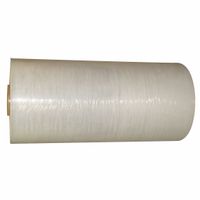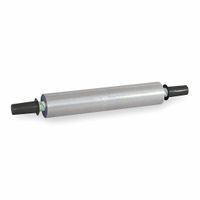Call +(254) 703 030 000 / 751 483 999 / 721 704 777
- Home
- Packaging Shipping
- Stretch Wrap
- Stretch Wrap Rolls
- General Purpose Stretch Wrap
.....Read More
Frequently Asked Questions
What is the difference between hand-grade and machine-grade stretch wrap?
Hand-grade stretch wrap is designed for manual application, typically used in smaller operations or for wrapping irregularly shaped items. It is lighter, more flexible, and easier to handle, allowing workers to apply it without specialized equipment. Hand-grade wrap usually comes in smaller rolls, making it convenient for manual use, and is ideal for low-volume packaging needs.
Machine-grade stretch wrap, on the other hand, is intended for use with stretch wrap machines. It is generally thicker and stronger, providing greater tension and load stability. This type of wrap is used in high-volume operations where speed and consistency are crucial. Machine-grade wrap comes in larger rolls, reducing the need for frequent roll changes, and is applied using automated equipment, ensuring uniform application and reducing labor costs.
In summary, the main differences lie in their application methods, thickness, strength, and suitability for different volume needs. Hand-grade is for manual, low-volume use, while machine-grade is for automated, high-volume operations.
How do you properly use hand-grade stretch wrap?
To properly use hand-grade stretch wrap, follow these steps:
1. **Preparation**: Ensure the load is stable and items are stacked evenly on the pallet. Remove any sharp edges or protrusions that could tear the wrap.
2. **Select the Right Wrap**: Choose the appropriate thickness and width of the stretch wrap based on the weight and size of the load. Hand-grade stretch wrap is typically lighter and easier to handle.
3. **Start Wrapping**: Begin at the base of the pallet. Secure the end of the wrap by tucking it under a corner of the load or tying it to the pallet.
4. **Apply Tension**: Hold the roll firmly and pull it to create tension. This tension is crucial for the wrap to cling tightly to the load.
5. **Wrap the Base**: Circle the base of the pallet at least two to three times to anchor the load securely. Overlap each layer by about 50% to ensure coverage and stability.
6. **Spiral Upwards**: Continue wrapping in a spiral motion, moving upwards. Maintain consistent tension and overlap as you ascend. Ensure each layer overlaps the previous one by about 50%.
7. **Secure the Top**: Once you reach the top, wrap it two to three times to secure the load. If the load is taller, consider wrapping back down to the base for added stability.
8. **Finish and Cut**: Once the load is fully wrapped, cut the film with a knife or scissors. Press the end of the wrap against the load to secure it.
9. **Inspect**: Check for any loose ends or gaps. Ensure the wrap is tight and the load is stable.
10. **Safety**: Use proper lifting techniques to avoid strain, and wear gloves to protect your hands from cuts or friction burns.
What are the benefits of using stretch wrap for shipping and storage?
Stretch wrap offers several benefits for shipping and storage:
1. **Protection**: It shields products from dust, dirt, moisture, and UV rays, ensuring goods remain clean and undamaged.
2. **Stability**: By tightly securing items on a pallet, stretch wrap prevents shifting during transit, reducing the risk of damage.
3. **Cost-Effective**: Stretch wrap is relatively inexpensive compared to other packaging materials, offering a cost-efficient way to secure and protect goods.
4. **Versatility**: It can be used for various products, regardless of shape or size, making it suitable for diverse shipping and storage needs.
5. **Efficiency**: Application is quick and easy, whether done manually or with a machine, saving time in the packaging process.
6. **Visibility**: Being transparent, it allows for easy identification of products without unwrapping, facilitating inventory management.
7. **Security**: Stretch wrap can deter tampering and theft, as any interference is easily noticeable.
8. **Environmentally Friendly**: Many stretch wraps are recyclable, contributing to sustainable packaging practices.
9. **Load Containment**: It provides excellent load containment, ensuring that products remain tightly packed together, which is crucial for safe transportation.
10. **Flexibility**: Available in various thicknesses and strengths, it can be tailored to specific needs, from light to heavy-duty applications.
11. **Space Saving**: By tightly wrapping items, it minimizes the space required for storage, optimizing warehouse capacity.
12. **Reduced Waste**: Stretch wrap minimizes the need for additional packaging materials, reducing overall waste.
These benefits make stretch wrap a popular choice for businesses looking to enhance the safety, efficiency, and cost-effectiveness of their shipping and storage operations.
How do you choose the right thickness of stretch wrap?
To choose the right thickness of stretch wrap, consider the following factors:
1. **Load Type**: Determine if the load is light, medium, or heavy. Light loads (up to 1,000 lbs) typically require thinner wrap (50-60 gauge), medium loads (1,000-2,000 lbs) need medium thickness (70-80 gauge), and heavy loads (over 2,000 lbs) require thicker wrap (90+ gauge).
2. **Load Stability**: Assess the stability of the load. Stable loads with uniform shapes can use thinner wrap, while unstable or irregularly shaped loads need thicker wrap for better containment.
3. **Transportation and Handling**: Consider the conditions during transit. If the load will be handled multiple times or transported over long distances, a thicker wrap may be necessary to withstand potential punctures and tears.
4. **Environmental Conditions**: Evaluate the storage and shipping environment. For loads exposed to extreme temperatures or outdoor conditions, thicker wrap provides better protection.
5. **Cost Efficiency**: Balance the cost with the protection level. Thicker wraps are more expensive, so choose the minimum thickness that provides adequate protection to optimize costs.
6. **Stretch Wrap Type**: Different types of stretch wrap (e.g., cast, blown) have varying strengths and stretch capabilities. Blown wrap is more puncture-resistant and suitable for heavy loads, while cast wrap is clearer and quieter, ideal for lighter loads.
7. **Machine vs. Hand Application**: Machine-applied wraps can be thinner due to consistent tension, while hand-applied wraps might need to be thicker to ensure uniform application.
By evaluating these factors, you can select the appropriate stretch wrap thickness to ensure load safety and cost-effectiveness.
Can stretch wrap be recycled?
Yes, stretch wrap can be recycled, but the process and feasibility depend on several factors. Stretch wrap, typically made from linear low-density polyethylene (LLDPE), is a type of plastic that is recyclable. However, its recycling is not as straightforward as other materials due to its thin, flexible nature, which can cause issues in standard recycling machinery by tangling or clogging the equipment.
To recycle stretch wrap effectively, it must be clean and free from contaminants such as labels, adhesives, or food residues. Many recycling facilities require stretch wrap to be collected separately from other recyclables to prevent contamination and ensure efficient processing. Some facilities have specialized equipment to handle and recycle stretch wrap, turning it into pellets that can be used to manufacture new plastic products.
Businesses and individuals can contribute to the recycling of stretch wrap by participating in dedicated recycling programs. Many commercial operations, such as warehouses and distribution centers, generate large quantities of stretch wrap and often have systems in place to collect and recycle it. For consumers, some retail stores and community recycling centers offer drop-off locations specifically for plastic films, including stretch wrap.
It's important to check with local recycling programs to understand their specific guidelines and capabilities regarding stretch wrap recycling. In areas where recycling options are limited, reducing usage or reusing stretch wrap when possible can also help minimize environmental impact.
What are the common sizes of stretch wrap rolls?
Common sizes of stretch wrap rolls vary based on the application and type of stretch wrap being used. Here are the typical sizes:
1. **Hand Stretch Wrap:**
- **Width:** Common widths are 12 inches, 15 inches, and 18 inches.
- **Length:** Roll lengths typically range from 1,000 feet to 1,500 feet.
- **Thickness:** Usually between 60 gauge and 120 gauge.
2. **Machine Stretch Wrap:**
- **Width:** Standard widths are 20 inches and 30 inches.
- **Length:** Roll lengths can range from 5,000 feet to 9,000 feet.
- **Thickness:** Typically between 50 gauge and 120 gauge.
3. **Mini Stretch Wrap:**
- **Width:** Usually 2 inches, 3 inches, or 5 inches.
- **Length:** Roll lengths are generally between 500 feet and 1,000 feet.
- **Thickness:** Typically around 80 gauge.
4. **Extended Core Stretch Wrap:**
- **Width:** Commonly 15 inches and 18 inches.
- **Length:** Roll lengths are similar to hand stretch wrap, ranging from 1,000 feet to 1,500 feet.
- **Thickness:** Usually between 60 gauge and 120 gauge.
5. **Bundling Stretch Wrap:**
- **Width:** Typically 3 inches to 5 inches.
- **Length:** Roll lengths are generally between 500 feet and 1,000 feet.
- **Thickness:** Usually around 80 gauge.
These sizes cater to different needs, from securing small items to wrapping large pallets. The choice of size depends on the specific application, the type of load being wrapped, and the equipment used.
How do you prevent stretch wrap from tearing during application?
To prevent stretch wrap from tearing during application, follow these steps:
1. **Choose the Right Film**: Select a high-quality stretch wrap with appropriate thickness and strength for your load. Thicker films are more resistant to tearing.
2. **Proper Tension**: Adjust the tension on the stretch wrap dispenser. Too much tension can cause tearing, while too little can lead to loose wrapping.
3. **Smooth Edges**: Ensure that the edges of the load are smooth and free from sharp objects or protrusions that can puncture the film.
4. **Correct Technique**: Use a consistent wrapping technique. Start at the bottom of the load and work your way up, overlapping each layer by about 50%. This provides better support and reduces the risk of tearing.
5. **Pre-Stretch Film**: Use pre-stretched film if possible. It is less likely to tear and provides better load stability.
6. **Avoid Overstretching**: Do not overstretch the film beyond its elastic limit, as this can weaken it and lead to tears.
7. **Use Corner Protectors**: Apply corner protectors to sharp edges or corners to prevent the film from tearing.
8. **Check Equipment**: Regularly maintain and check the wrapping equipment for any defects or issues that could cause uneven tension or application.
9. **Environmental Conditions**: Be mindful of environmental factors such as temperature and humidity, which can affect the film's performance. Store the film in a controlled environment.
10. **Training**: Ensure that all operators are properly trained in the correct use of stretch wrap and equipment to minimize errors that could lead to tearing.
By following these guidelines, you can significantly reduce the risk of stretch wrap tearing during application.


